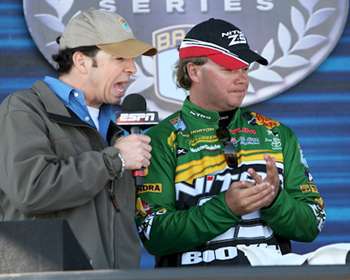
Technology has increased an angler's options for all things related to the sport of bass fishing. However, with new technology, there is sometimes the urge to ditch old standbys for the latest and greatest. Such is the case with braided line. Once a staple in bass fishing, braid fell out of favor as monofilament and fluorocarbon lines improved. Recently, there's been a resurgence in the popularity of braided line.
Elite Series pro Tim Horton is prime example of a veteran angler who knew a good thing when he found it. In fact, he says braided line has earned a place beyond being a "winch cable" in heavy-cover situations. "Ninety percent of the time when I'm around heavy cover, either grass or wood, I'm using braided line," he says. "But to be honest, if my line doesn't need to be transparent the way fluorocarbon and monofilament are, I'll go with braid."
The current trend in bass fishing is using braided line not only around heavy cover, but also with topwater applications.
"It's really to a point where there are a lot more scenarios where you'll see anglers using braid," he says. "I know that when the Elites fish Clarks Hill this year, you'll see guys throwing the big Zara Spook on braided line. There are a lot of other applications that are becoming more applicable for braided line, that's for sure."
One of those "other applications" arose during the 2009 Elite Series stop on Texas' Lake Amistad, where Horton paired a deep diving crankbait with braided line. "I could bring that bait through the trees and bounce it off every piece of cover without worrying about getting a nick in my line," He remembers. "If I can fish braid and not have to worry about breaking off, it's worth it. It just has to be the right situation where the line doesn't create too much of a contrast in the water."
One of the missteps novice anglers make with braided line is using a line heavier than necessary. "When you're flipping milfoil rather than hydrilla, you can get away with using 30-pound braid instead of 65-pound line," he points out.
As stated earlier, unlike its monofilament or fluorocarbon cousins, braided line is not transparent and stands out in clear water. It's for this reason that Horton will typically color the first 4 to 5 feet of his line above the hook with black permanent marker.
"You want to keep that bait hidden around the dark cover; that's really important," he says. "As you use braid all day long, the water will bleach it out and make it even brighter. It becomes even more important to darken the first several feet."
Horton admits that braided line is prone to making a lot more noise as it's pulled through heavy cover, which is something that he's very conscious of when making his initial selection. "Because of the material it's made out of, it's going to give off a lot more noise in heavy cover — particularly grass," he says.
"I like a braid that's softer and doesn't make a lot of noise when I'm pulling it through the cover."




